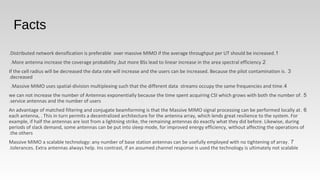Massive mimo
- 1. Massive MIMO Mustafa Khaleel APWC Course (Advanced Wireless Telecommunications- Master Program) Politehnica University of Bucharest
- 2. Contents MIMO Single user MIMO & Multi-user MIMO What is Massive MIMO ? Massive MIMO Key Features Explanations TDD and FDD mode Pilot Contamination Mitigation Pilot Contamination Mm-wave and Massive Facts
- 3. MIMO MIMO (multiple input, multiple output) is an antenna technology for wireless communications in which multiple antennas are used at both the source (transmitter) and the destination (receiver).
- 4. Single user MIMO & Multi-user MIMO SU-MIMO: the data of a single user is transmitted simultaneously on several parallel data streams (All streams to one user ). MU-MIMO : the individual streams are assigned to various users (Larger diversity gain than single user MIMO)
- 5. What is Massive MIMO ? A very large antenna array at each base station A large number of users are served simultaneously
- 6. Massive MIMO Key Features Benefits from the (many) excess antennas Differences with MU-MIMO in conventional cellular systems Main benefits: huge spectral efficiency and high reliability high energy efficiency
- 7. Explanations Wireless Communication suffers from attenuation in signal strength and Interference between users and MIMO is well Known solution against Massive MIMO promises additional advantage over standard solutions. According to Shannon theorem the channel capacity : Capacity (bits/sec )= Available spectrum (Hz)*spectral efficiency(dB) Where C is known as capacity of channel, B is known as bandwidth of the signal, S/N is known as signal to noise ratio. MT is the number of antennas used at the transmitter side & MR is the number of antennas used at receiver side.
- 8. • We need a pilot signal for Channel state information (CSI) estimation , but there are two problems • First, optimal downlink pilots should be mutually orthogonal between the antennas. This means that the amount of time frequency resources needed for downlink pilots scales as the number of antennas, so a massive MIMO system would require up to a hundred times more such resources than a conventional system. • Second, the number of channel responses that each terminal must estimate is also proportional to the number of base station antennas. Hence, the uplink resources needed to inform the base station about the channel responses would be up to a hundred times larger than in conventional systems . • The solution is to operate in TDD mode, and rely on reciprocity between the uplink and downlink channels. • TDD operation is better than FDD in Massive MIMO because in TDD we need TDD and FDD Mode
- 9. Pilot Contamination In multi-cell systems, we cannot assign orthogonal pilot sequences for all users in all cells, due to the limitation of the channel coherence interval. Orthogonal pilot sequences have to be reused from cell to cell. Therefore, the channel estimate obtained in a given cell will be contaminated by pilots transmitted by users in other cells. This effect, called “pilot contamination”, reduces the system performance, also the interference between users The Pilot signals from resources are used for synchronization and equalization. Also estimate the channel state information.
- 10. Mitigation Pilot Contamination 1.Pilot Open-Loop Power Control 2.Less Aggressive Pilot Reuse 3.Soft Pilot Reuse
- 11. Pilot Open-Loop Power Control a pilot open loop power control (pilot OLPC) scheme that allows the terminal to adjust the transmit power of its pilot signal .based on its estimate of the path loss to its serving BS
- 12. Less Aggressive Pilot Reuse Pilot reuse is analogous to the traditional frequency reuse in the sense that terminals within the pilot reuse area can utilize only a fraction of the time-frequency resources, during the channel estimation phase. The pilot reuse factor 1/U is the rate at which pilot resources may be reused in the network, where U is the number of cells that are assigned orthogonal pilots .
- 13. Soft Pilot Reuse
- 14. mmWave and massive MIMO in cellular Directivity of massive MIMO compensates for high mm-Wave attenuation, reduces multipath and multiuser interference. Mm-Wave frequencies reduce the size required for massive MIMO antenna arrays. Massive MIMO testbed, Lund University, 2014
- 15. Facts 1.Distributed network densification is preferable over massive MIMO if the average throughput per UT should be increased. 2.More antenna increase the coverage probability ,but more BSs lead to linear increase in the area spectral efficiency. 3.If the cell radius will be decreased the data rate will increase and the users can be increased. Because the pilot contamination is decreased. 4.Massive MIMO uses spatial-division multiplexing such that the different data streams occupy the same frequencies and time. 5.we can not increase the number of Antennas exponentially because the time spent acquiring CSI which grows with both the number of service antennas and the number of users. 6.An advantage of matched filtering and conjugate beamforming is that the Massive MIMO signal processing can be performed locally at each antenna, . This in turn permits a decentralized architecture for the antenna array, which lends great resilience to the system. For example, if half the antennas are lost from a lightning strike, the remaining antennas do exactly what they did before. Likewise, during periods of slack demand, some antennas can be put into sleep mode, for improved energy efficiency, without affecting the operations of the others. 7.Massive MIMO a scalable technology: any number of base station antennas can be usefully employed with no tightening of array tolerances. Extra antennas always help. Ins contrast, if an assumed channel response is used the technology is ultimately not scalable.
- 16. References 1.Division of Communication Systems Department of Electrical Engineering (ISY) Linköping University, SE-581 83 Linköping, Sweden www.commsys.isy.liu.s 2.Nimay Ch. Giri1, Anwesha Sahoo2, J. R. Swain3, P. Kumar4, A. Nayak5, P. Debogoswami6 Lecturer, Department of ECE, 2,3,4,5,6B.Tech Scholar, Centurion University of Technology and Management, Odisha, India 3.http://www.researchgate.net/post/What_is_the_acheivable_Massive_MIMO_capacity(Emil Björnson) 4.http://www.hindawi.com/journals/ijap/2014/848071/ 5.https://www.youtube.com/watch?v=zhncADqR9rg 6.Thomas L. Marzetta heads the LargeScale Antenna Systems Group in the Network Energy Program at Bell Labs in Murray Hill 7.https://www.youtube.com/watch?v=imLiaLQGmB8















